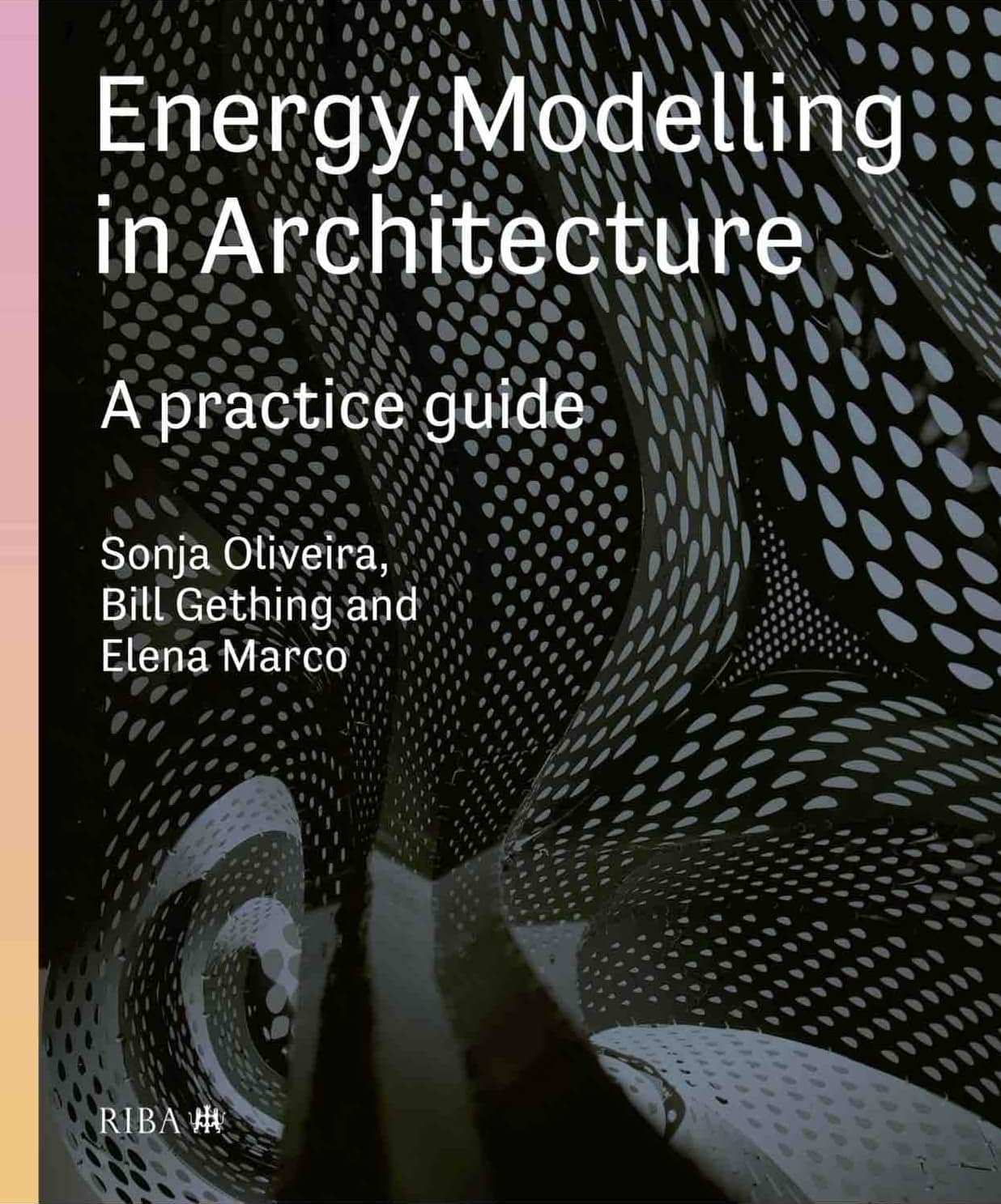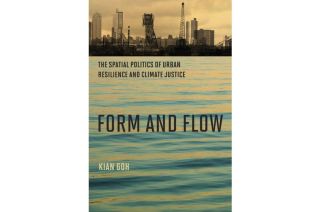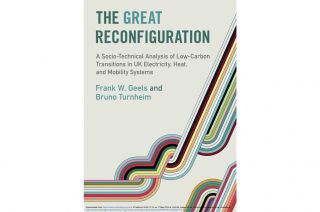
www.buildingsandcities.org/insights/reviews/energy-modelling-in-architecture.html
Energy Modelling in Architecture: A Practice Guide
By Sonja Oliviera, Bill Gething, Elena Marco. RIBA Publishing, 2020, ISBN 9781859469101
Malcolm J Cook reviews this practice guide, which offers a unique insight into the social and organisational challenges facing architectural practices engaged in energy modelling and provides several practical examples. The book is a must read for practitioners, educators and researchers involved in energy modelling, as well as new starters.

Buildings that overheat in summer or waste energy are still too common. We know how to design healthy, low-energy buildings, and have affordable tools and models at our disposal to avoid these problems. In a world where accurate energy prediction of building designs is so important, an appreciation of the concepts and experiences of energy modelling is of fundamental importance. This knowledge should be embedded in appropriate university courses and design practice. This book is aimed at the latter. There are many books available on energy modelling that provide much detail on algorithms, mathematical models and solution techniques. That is not what this book is about. Instead, this book focuses on the social and organisational processes that enable effective energy analysis to be integrated into architectural practice. Through case studies and the experience of practicing architects we learn why this is not straightforward.
The book is a compilation of experiences and viewpoints which avoids a narrowness of views. Compiled by editors who understand practitioners, educators and researchers, it offers a unique insight into the challenges facing architectural practices engaged in energy modelling and their experiences. It embraces the now well-established premise that collaboration is essential. The key to successful low energy design is for architects to work closely with engineers. By considering building performance early in the design process, an effective dialogue is created, offering the important opportunity for all parties to share and understand performance aspirations and co-create appropriate solutions.
The book repeatedly comes back to the benefits of energy modelling and how this has been successfully employed, rather than losing its way in pure architectural design:
'The process of modelling the building … means that designers can drill down into all elements of the building and focus on optimising them in terms of energy and design …'. [p. 76]At the same time, the book, quite rightly, avoids detailed discussions of specific codes and software packages but rather focuses on the purpose (and benefits) of energy modelling. For example, we read how the collective use of different modelling tools:
'enabled the design team to tune the building façade to maximise the energy-saving potential …' [p. 60]
Intelligent use of energy modelling is further exemplified by the authors who propose an energy modelling workflow using goal setting and images to facilitate the communication between members of the design team.
The book's editors offer complementary experiences of architectural practice, education and research. This is evident as the reader turns the pages and observes how the case study materials are presented with a healthy amount of academic rigour that provides the confidence necessary to embrace the ideas presented. Chapter 1 presents the findings from a research study in which interviews and focus group discussions were facilitated with large architecture practices. This enabled a greater understanding of an organisation's approaches to learning how best to use energy modelling tools. The editors also present some interesting insights into university curricula and how interdisciplinary learning, comprising building physics, building services and architecture are key to enabling successful integrated design in practice.
It is insightful to read about the challenges faced by large practices and how these differ to small practices. These challenges include social and organisational leadership and the relationship between the client and the designer. But above all, a collaborative, multi-disciplinary language is key. Many of the contributors highlight the need to understand integration of energy modelling as a socio-technical process in design, not just a technical endeavour. For example, readers are warned about asking:
'questions of energy models that they are simply not intended for' and to understand the 'goal of and claims made about energy models'. [p. 38]
The authors make valuable suggestions such as the benefits of a shared and co-authored energy model that facilitates design iterations, a great means of communication, understanding and shared workflow leading to a so-called new 'shared workflow culture'.
Universities delivering courses in the area of architectural engineering and building services will do well to embrace all these ideas when developing and revising curricula. For example, by promoting inter-disciplinary thinking, collaboration between architects and engineers, and a sound understanding of the role, claims, assumptions and limitations of energy models.
The case studies offer a useful insight into what type and level of energy modelling an architecture practice might consider, bearing in mind the skills of the practice, time available, and what features would have most impact on the final outcome. There are many examples of how to present modelling results in a coherent, meaningful way such that early-stage design questions are answerable with confidence. This is invaluable for architects as it points to the end goal of the modelling exercise, enabling them to ask the right questions of the client and of themselves, gather the appropriate input data and avoid unnecessary simulation.
At appropriate points in the book, the contributors consider what level of modelling accuracy can be expected. When thinking about accuracy, it is important to also think about how and when to monitor real buildings, the role of model validation and the value of data collected via post-occupancy evaluation (POE). All these points are covered in the book, including the latest ideas around submetering and how POE can inform early-stage energy modelling.
The case studies and practitioner accounts offer insights for those who have not yet established an energy modelling capability. The book offers confidence to these stakeholders and points towards the types of tool newcomers to the field might consider. All readers will relate to one or more of the case studies which should fuel their enthusiasm to explore the benefits of energy modelling.
Practitioners will find this book offers useful insights into the subject of energy modelling in architecture. A variety of case studies and experiences make the topic accessible. It covers new build projects but is of equal value for retrofit projects, enabling useful side-by-side comparisons of design options and enabling an understanding of the energy impact of each intervention.
This book is a must read for all architects considering or involved in energy modelling as well as educators responsible for training the generation of designers who will make energy efficient design the norm. For those not involved in modelling, this book provides you with the knowledge you need to ask the right questions, communicate results effectively and design more comfortable, energy efficient buildings.
Latest Peer-Reviewed Journal Content
Acceptability of sufficiency consumption policies by Finnish households
E Nuorivaara & S Ahvenharju
Key factors for revitalising heritage buildings through adaptive reuse
É Savoie, J P Sapinski & A-M Laroche
Cooler streets for a cycleable city: assessing policy alignment
C Tang & J Bush
Understanding the embodied carbon credentials of modern methods of construction
R O'Hegarty, A McCarthy, J O'Hagan, T Thanapornpakornsin, S Raffoul & O Kinnane
The changing typology of urban apartment buildings in Aurinkolahti
S Meriläinen & A Tervo
Embodied climate impacts in urban development: a neighbourhood case study
S Sjökvist, N Francart, M Balouktsi & H Birgisdottir
Environmental effects of urban wind energy harvesting: a review
I Tsionas, M laguno-Munitxa & A Stephan
Office environment and employee differences by company health management certification
S Arata, M Sugiuchi, T Ikaga, Y Shiraishi, T Hayashi, S Ando & S Kawakubo
Spatiotemporal evaluation of embodied carbon in urban residential development
I Talvitie, A Amiri & S Junnila
Energy sufficiency in buildings and cities: current research, future directions [editorial]
M Sahakian, T Fawcett & S Darby
Sufficiency, consumption patterns and limits: a survey of French households
J Bouillet & C Grandclément
Health inequalities and indoor environments: research challenges and priorities [editorial]
M Ucci & A Mavrogianni
Operationalising energy sufficiency for low-carbon built environments in urbanising India
A B Lall & G Sethi
Promoting practices of sufficiency: reprogramming resource-intensive material arrangements
T H Christensen, L K Aagaard, A K Juvik, C Samson & K Gram-Hanssen
Culture change in the UK construction industry: an anthropological perspective
I Tellam
Are people willing to share living space? Household preferences in Finland
E Ruokamo, E Kylkilahti, M Lettenmeier & A Toppinen
Towards urban LCA: examining densification alternatives for a residential neighbourhood
M Moisio, E Salmio, T Kaasalainen, S Huuhka, A Räsänen, J Lahdensivu, M Leppänen & P Kuula
A population-level framework to estimate unequal exposure to indoor heat and air pollution
R Cole, C H Simpson, L Ferguson, P Symonds, J Taylor, C Heaviside, P Murage, H L Macintyre, S Hajat, A Mavrogianni & M Davies
Finnish glazed balconies: residents' experience, wellbeing and use
L Jegard, R Castaño-Rosa, S Kilpeläinen & S Pelsmakers
Modelling Nigerian residential dwellings: bottom-up approach and scenario analysis
C C Nwagwu, S Akin & E G Hertwich
Mapping municipal land policies: applications of flexible zoning for densification
V Götze, J-D Gerber & M Jehling
Energy sufficiency and recognition justice: a study of household consumption
A Guilbert
Linking housing, socio-demographic, environmental and mental health data at scale
P Symonds, C H Simpson, G Petrou, L Ferguson, A Mavrogianni & M Davies
Measuring health inequities due to housing characteristics
K Govertsen & M Kane
Provide or prevent? Exploring sufficiency imaginaries within Danish systems of provision
L K Aagaard & T H Christensen
Imagining sufficiency through collective changes as satisfiers
O Moynat & M Sahakian
US urban land-use reform: a strategy for energy sufficiency
Z M Subin, J Lombardi, R Muralidharan, J Korn, J Malik, T Pullen, M Wei & T Hong
Mapping supply chains for energy retrofit
F Wade & Y Han
Operationalising building-related energy sufficiency measures in SMEs
I Fouiteh, J D Cabrera Santelices, A Susini & M K Patel
Promoting neighbourhood sharing: infrastructures of convenience and community
A Huber, H Heinrichs & M Jaeger-Erben
New insights into thermal comfort sufficiency in dwellings
G van Moeseke, D de Grave, A Anciaux, J Sobczak & G Wallenborn
'Rightsize': a housing design game for spatial and energy sufficiency
P Graham, P Nourian, E Warwick & M Gath-Morad
Implementing housing policies for a sufficient lifestyle
M Bagheri, L Roth, L Siebke, C Rohde & H-J Linke
The jobs of climate adaptation
T Denham, L Rickards & O Ajulo
Structural barriers to sufficiency: the contribution of research on elites
M Koch, K Emilsson, J Lee & H Johansson
Disrupting the imaginaries of urban action to deliver just adaptation [editorial]
V Castán-Broto, M Olazabal & G Ziervogel
Nature for resilience reconfigured: global- to-local translation of frames in Africa
K Rochell, H Bulkeley & H Runhaar
How hegemonic discourses of sustainability influence urban climate action
V Castán Broto, L Westman & P Huang
Fabric first: is it still the right approach?
N Eyre, T Fawcett, M Topouzi, G Killip, T Oreszczyn, K Jenkinson & J Rosenow
Social value of the built environment [editorial]
F Samuel & K Watson
Understanding demolition [editorial]
S Huuhka
Data politics in the built environment [editorial]
A Karvonen & T Hargreaves



Latest Commentaries
Decolonising Cities: The Role of Street Naming
During colonialisation, street names were drawn from historical and societal contexts of the colonisers. Street nomenclature deployed by colonial administrators has a role in legitimising historical narratives and decentring local languages, cultures and heritage. Buyana Kareem examines street renaming as an important element of decolonisation.
Integrating Nature into Cities
Increasing vegetation and green and blue spaces in cities can support both climate change mitigation and adaptation goals, while also enhancing biodiversity and ecological health. Maibritt Pedersen Zari (Auckland University of Technology) explains why nature-based solutions (NbS) must be a vital part of urban planning and design.